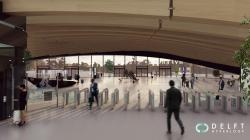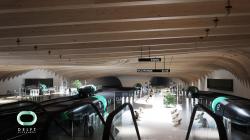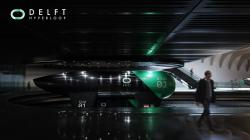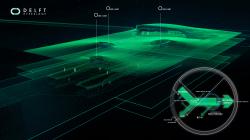Delft Hyperloop is a team of students from the Delft University of Technology in the Netherlands, that competes in SpaceX’s Hyperloop Pod Competition. This competition is held annually at SpaceX’s headquarters in Los Angeles where over 1000 student teams apply to compete, about 30 are qualified to go to SpaceX and only 3 teams are finally picked out after a series of tests to actually run in the 1.2km tube which is laid out just outside of the rocket facility of SpaceX. The main criteria for the competition is speed, where the fastest Pod wins, however criterias for the competition of 2016 were the best overall won. Delft Hyperloop I came in 1st place in 2016 and Delft Hyperloop II -an almost entirely new team of students - came in 2nd place this year. However, our team does not only go for the win, we also work out our vision on what the Hyperloop will fundamentaly be like and how the main concept will work. Just before this event in July, we revealed our vision of the full Hyperloop system, covering fundamental aspects from pod design and propulsion system to infrastructure and architecture.
At Delft Hyperloop we propose a network which will run from Amsterdam, through Brussels, to Paris in just about 30 minutes. From here, an entire European network will expand, becoming the foundation of high-speed ground transportation. In and around highly dense cities, the Hyperloop will run mainly underground. The Pods will levitate with magnets from one station to another in vacuum tubes at airline speeds (1000km/h) given the low air resistance within the tubes, significantly reducing the amount of time passengers would have travel. The Hyperloop will be powered by renewable energy where solar panels will be integrated onto the tubes and at stations.
We believe international cooperation regarding dimensions and regulations within and around the station would be fundamental for the system to operate as swiftly as possible from one city to the next. We also believe, the station would not have to massively invade urban spaces, due to its underground infrastructure. Having in mind that high density cities are one of the main targets to host the Hyperloop, it is necessary to take the magnitude of the infrastructure in these contexts into account. This team therefore promotes the idea of using a standardisation of modular layouts for all stations, adapting them into the different contexts through independent designs.
As the Pods arrive at a lower level (-2), passengers will de-board and be directed to the main area (cafe, stores, etc), meanwhile the Pods are taken to the departure level above (-1) by a lift -much like those used at modern-day underground parking lots- and then transferred (through automation) to a pre-designated platform. Each platform will have its own check-in and security system, allowing Pods to reach a 1 minute departure/arrival frequency. These dynamic passenger flows and pod flows are essential for the Hyperloop to be as effective as possible. Once the passenger is fastened to the seats, the pod moves to the airlock chambers where the surrounding air is depressurised (near vacuum) and the interior air is pressurised for a safe and comfortable environment during the journey. Multiple vacuum chambers would be available in order to grant flexibility at high peak hours of the users. With this system, passengers would have no need to wait in line for hours like at airports. The station would feel a bit more like a metro station than anything else.
The station, designed by Francisco Muñoz-Correa, was intended to show a nearby future and how the Hyperloop will look like with all of it’s technologies. The wood shares an appreciation for sustainable design and plays a key role for the future in the eyes of our architect. Since the station will be mainly underground - as so would the airlocks and tubes at this point - there is a need for natural lighting and the light created in the station suggests a double function as it also becomes part of the landscape at ground level. At ground level, the station invites users to interact with the landscape designed to be harmoniously connected with public transportation such as trams and buses.
Different sized Pods would be available to the users depending on demand and function, varying from 6 to 50 people per pod and granting possibility for cargo transport. Our team designed and built a half scaled Pod of the smallest Pod size that would be able to function in such conditions of high frequency passenger flows.
2018
0000
The following link shares the vision of the project:
https://www.youtube.com/watch?v=Fnll6dEZnoY
The project was made within the Delft Hyperloop Team competing in the SpaceX Hyperloop Pod competition. The station was designed by Francisco Muñoz-Correa, with some help from Arwin Hidding.
Favorited 1 times











